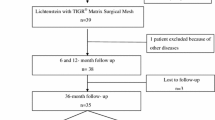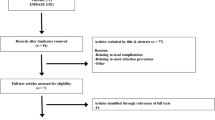Abstract
To investigate the clinical safety and effectiveness of acellular extracellular matrix (AEM) for inguinal hernia repair, 53 well-conducted and well-chosen sequential cases with inguinal hernia (56 inguinal hernias) were included in our multi-center study. All the inguinal hernias were repaired using conventional tension-free surgical procedures after being classified with Gilbert methods. No rejection was observed after operation. All the incisions healed well and no recurrence was found at the sixth month follow-up. At the seventh month after operation, one case of recurrence of right-side bilateral inguinal hernia (type IV) and another case of recurrence of left-side inguinal hernia (type V) were found. No other recurrence was observed at the 18th month follow-up. The AEM material has good histocompatibility and biomechanics characters and can be used for inguinal hernia repair. We observed no infection, chronic pain, funiculotesticular reaction, local nodular or feeling of discomfort after operation. But a further study of the usage of AEM in the repair of type IV and V inguinal hernias is still needed.
Similar content being viewed by others
References
Disa JJ, Goldberg NH, Carlton JM et al (1998) Restoring abdominal wall integrity in contaminated tissue-deficient wounds using autologous fascia grafts. Plast Reconstr Surg 101:979–986
Disa JJ, Chairamonte MF, Girotto JA et al (2001) Advantages of autologous fascia versus synthetic patch abdominal reconstruction in experimental animal defects. Plast Reconstr Surg 108:2086–2087
Hein KD, Morris DJ, Goldwyn RM et al (1998) Dermal autografts for fascial repair after TRAM flap harvest. Plast Reconstr Surg 102:2287–2292
Yu-Ray C, Yeow VKL (1999) Cleft lip scar camouflage using dermal micrografts. Plast Reconstr Surg 103:1250–1253
Choe JM, Kothandapani R, James L et al (2001) Autologous, cadaveric, and synthetic materials used in sling surgery: comparative biomechanical analysis. Urology 58:482–486
Witt PD, Cheng CJ, Mallory SB et al (1999) Surgical treatment of pseudosyndactyly of the hand in epidermolysis bullosa: histological analysis of an acellular allograft dermal matrix. Ann Plast Surg 43:379–385
Author information
Authors and Affiliations
Corresponding author
Rights and permissions
About this article
Cite this article
Ma, S.Z., Li, X.H. & Hu, J. Acellular extracellular matrix for inguinal hernia repair. Hernia 10, 229–231 (2006). https://doi.org/10.1007/s10029-006-0071-9
Received:
Accepted:
Published:
Issue Date:
DOI: https://doi.org/10.1007/s10029-006-0071-9




